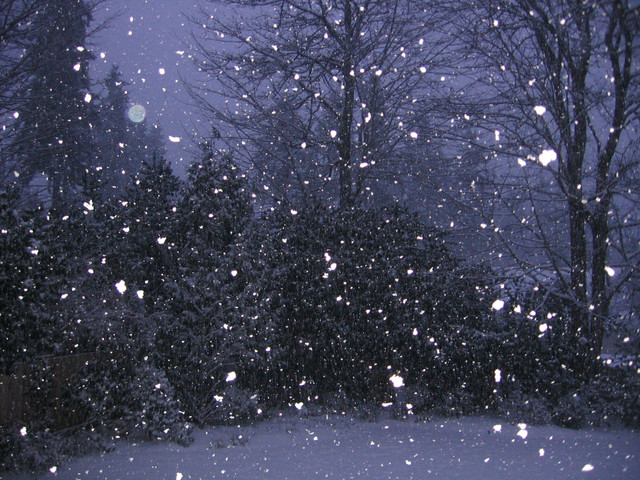Snowfall is
associated with colder climates and regions where people are
accustomed to accumulation. Even though there
may be freezing temperatures at high altitudes, it is not
uncommon for snow to fall and change its phase from solid to
liquid before reaching the ground.
Water droplets and ice crystals forming in
clouds are subjected to gravitational
forces and fall, however the particles are small
enough that they do not fall fast. Clouds maintain altitudes from
air currents, temperatures, densities, and pressures. Precipitation
occurs when particles collide and form bonds. This creates larger
and larger particles until they descend. Snowfall will
often transform from a solid state to a gaseous state, known
as sublimation, and back to a solid state several times on
its way to the ground.
Snow can also change its pattern
several times on its way to the ground. Patterns can change from columns
to plates to crystals, and back. Snow continually
changes its pattern because atmospheric conditions change
from the formation phase of snow until it reaches the
ground.
 |
This rimmed
snowflake is evidence of the collisions made by
snowflakes on their path to the ground. It is riddled with
rime, or ice crystals, that form when the snow collides and
bonds to water particles on its path through the air.
The path a snow
particle takes to the ground can be simple or complex. A simple path
would be a particle that is formed and falls in a straight
vertical line with a constant velocity to the
ground. A
complex path would be snow that is formed and follows an
inconsistent path in the vertical and horizontal direction
while undergoing accelerations and decelerations. (Though after
considering the real world
probability of occurrence, the simple path is
probably more complex and unique than a seemingly randomly
altering path.)
The best snowfall to consider
is the most simple, which is snow that falls at a constant
velocity from an initial height to a final height to the
ground. Kinematics
can produce the time taken for a particle to move from a cloud at ten thousand feet to
the ground, at a constant velocity of one foot per second.
t = (d/v), where t = time, d = distance, and v = velocity.
We get 10,000 seconds, or under three hours, for a
particle to fall from the cloud
to the ground. This is
reasonable given that “a snow
crystal can spend a few minutes to five or six hours
in the air.”8 Given the time a
particle can spend in the air, it’s possible for a
particle to travel great horizontal distances with
velocity in the horizontal direction. It is safe to
conclude that it is possible for a snowflake to reach the
ground after all clouds have passed and the sky has become
clear.
The velocity of a snowflake is determined through F = ma =
D - Fg. This
is where F = force, m = mass of the snowflake, a =
acceleration of the snowflake, D = the drag acting on the
snowflake and Fg = the gravitational force. We can find the
terminal velocity of a snowflake when the acceleration of
the snowflake becomes zero.
We then get D = Fg. The drag is
known by
D = (1/2)CρAv2 , where C = drag coefficient, ρ
= the density of air, A
= the cross section of the snowflake. “v” will be the
terminal velocity.9
Physics and energy
explain the transformations undergone by snow in the cloud, during its fall, and on
the ground. The particles
gain gravitational potential energy as they increase in
altitude and mass. When
snow falls, the gravitational energy is transformed into
kinetic energy and thermal energy. This describes
sublimation during free fall. Energy is not
just transformed into thermal energy but it is also
transformed by other forces from interactions with its
environment. Snow
has to collide enough times to maintain a large enough
mass and to possess enough energy to reach the ground. The accumulation of snow begins
a new interaction with the environment.
| Continue to
Accumulation Home |
